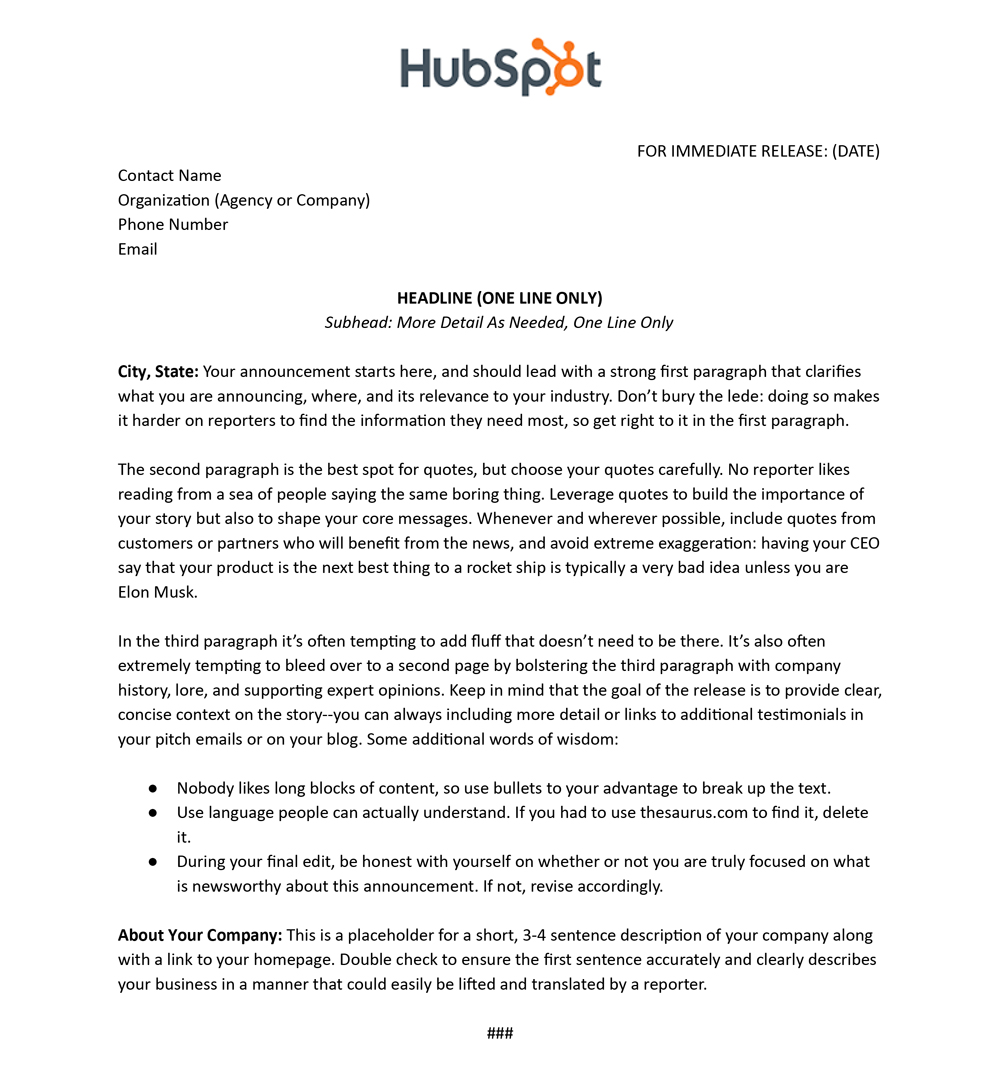Do you have a somewhat vague understanding about the purpose and value of a press release? Have you ever thought to yourself that your business is too small for press releases and only large businesses use press releases? Moreover, how, when, and why would you write a press release and who should you disseminate it to?
If you own a business, chances are you have had something newsworthy to share with the public you serve at some point. Your options to share this information might include a paid ad, but oftentimes a paid ad will not suffice in covering the information you need to share (without losing the message with overcrowding and too much copy). Moreover, why should you have to pay to share something newsworthy and chance losing some of the details that the public needs to know (due to limited ad space) when you could possibly obtain media coverage for free?
Press releases are a tried and true practice of disseminating your business’s announcement while staying within budget. If your announcement is newsworthy, well-written and follow the below guidelines, you should see an increase in coverage of your business especially as your media relations develop. If you effectively communicate with your news sources, those relationships will build with time (more on that towards the end).
What is a Press Release, Anyway?
According to the Merriam-Webster dictionary, a press release is an official statement that gives information to newspapers, magazines, television news programs, and radio stations. However, today this official statement (written or recorded) is not limited to the distribution of print media, but is issued to the digital media, social media, and beyond. A press release can also be referred to as a press statement or news release.
More importantly, a press release should be newsworthy to the audience of the publication you are sending it to. What is newsworthy to your business personally might not be newsworthy to the public or the media source you intend it for, so make sure you remain objective in determining the need for a press release.
- It is usually best to keep press releases to one page long. Two pages tops if your announcement is incredibly newsworthy with several press worthy details.
- For reference 200 – 400 words should suffice.
- Traditionally, businesses want to provide enough information (succinct, precise, no puffy details) so that news outlets have sufficient information to publish their own stories about the information in the release.
Historically, if the announcement is published in any of the main news channels, the journalist will either contact the business who issued the press release for more information and hopefully photos (you may want to request to meet in person to gather photos or request to submit your own) and write their own story using the details they gather. Sometimes, the journalist will write their own story just using the information from the press release. At other times, the press release will be published as submitted in a section dedicated to just press releases. Ultimately, you want the journalist to contact you for more information and photos, write an original piece, and publish.
Value for Businesses Big and Small
Press releases are valuable to businesses of any size. At Epic Nine, we write newsworthy press releases for a variety of our small business clients that are often times picked up by the local and regional press.
The value of a press release is – free press! Press releases are extremely cost effective as free coverage by trustworthy and credible news mediums can be incredibly valuable for your business. Moreover, press releases cost less than a series of paid ads and, oftentimes are more valuable than those paid ads. For example, an article that covers your service or product and seems to endorse or recommend it will more than likely drive potential customers or clients to contact you versus a paid ad.
Business Wire explains that outside of free press there are even more valuable advantages of press releases and these include:
- Building credibility (and authority) within an industry
- Increases customer consideration and interaction
- Increases opportunities to establish media relations
- Builds social relevance
- Increases traffic and, as a result, sales

Qualifications and Rules for Success
The success of a press release relies on how well the writer tells a story, the current relevance of the information, how personalized the pitch is to the media outlet, and the amount of understanding about the publication being sent too as well as the journalist’s beat.
Therefore, the information in the press release must first and foremost bring value to the journalist it is being sent too (i.e. be newsworthy to him or her). This relates to a business’s size as a small business opening its first store may want to keep their press release distribution to local and regional publications and online sources instead of focusing on a large national press release package. However, should that same small business grow substantially to operate numerous franchises, then their press releases would be worthy of a more national and larger distribution strategy.
The press release you are disseminating should state the who, what, when, where, and why of the announcement you want to share with the general public in simple, yet well-written, terms with uncomplicated sentences and phrases.
Do not extend sentences with biz blab to try to make something unimportant sound important. Worse case scenario in doing this is your business and/or marketing department will look clueless and idiotic and hurt the media relations that are key to providing coverage about your business.
I really like how CBS News sums up the when, why, and how of press releases with these few rules:
RULE #1:
Use the press release as a sales tool. The idea is to communicate a message to customers and prospects, through the vehicle of a print or online article, hopefully adding the authority and credibility of the publication, website and/or reporter to the message.
RULE #2:
Have a newsworthy story. To get your message communicated through the publication, you need to convince the reporter/editor that your message (or the story surrounding it) is newsworthy. So it’s got to have appeal to the entire readership of the publication.
RULE #3:
Write it like a reporter would write it. If your press release looks and feels like a real article, reporters will often just file it as a story with minimal editing. Therefore, it’s up to you to make sure that your press release looks and feels like a real article. No biz blab!
RULE #4:
Provide some good quotes. Even if your CEO is a complete idiot, don’t make him sound like one by providing a quote that’s a series of business cliches. Have him say something memorable and personal, if possible.
RULE #5:
Contact your top outlets personally. In addition to sending a press release, personally contact the reporters that you really want to cover the story. Send them something personal. You might even want to rewrite the press release to fit their beat.
Make sure you do your research on your various media outlets and find the right contact to send your release. It’s always better to do the research and find an actual person instead of a generic news@XYZ.com email address, but make sure you are sending it to the RIGHT person. If you are a small business, a spreadsheet should suffice in keeping your contacts organized. For bigger businesses, a company such a Cision might be a better choice for disseminating.

How to Build a Press Release
Now that we have discussed parameters for the content of a press release, let’s discuss the headline, format, quotes, and other essential elements to create the perfect press release condition. Take a look at the sample press release from one of my favorite resources, Hubspot.
-
Your Headline is Your Hook
It may seem daunting to create a catchy headline using only one sentence on one line, but it can be done! Use action verbs, understandable and clear language that is factual, yet entices the journalist/media outlet to continue reading.
It is worth the investment to write a compelling headline as this could make or break the success of your press release.
-
Be Upfront About Why Your News is Important
As Hubspot stated, “Don’t play hard to get”. The first paragraph of your release should cover the who, what, why, where, and how of your new launch, update, or development. Reporters don’t have a ton of time to sift through details and fluffy background information — they just need the facts that’ll help them tell your story to someone else from a position of authority.
-
Don’t Forget the Memorable Quote
Ideally, your quote should come in the second or third paragraph of your press release. Your quote should be given by a key stakeholder in your business, such as a board member or those in leadership positions, or those directly impacted by the announcement. This lends importance and credibility to the nature of your announcement.
Keep your quotes minimal to one or two at most and focus on the quotee’s perspective. Try not to make it sound like your usual, hum-drum statement. Bring your announcement to life with your quotes.
-
Your Last Paragraph Should Sum Up Your Business and the Release
Try not to be superfluous, but be straight to the point about who your business is and what your business does. If you have any esteemed awards or other notable projects, this would be the place to include them. Journalists and your audience should finish reading your press release with a clear understanding of your business and what you do.
If there are any future implications of your announcement, this would be the place to also include those. Also, include important links to your website and/or links pertinent to the announcement along with contact information and location information if applicable.
Don’t Forget Your Pitch
You’ve done your research and have your list of media contacts. You’ve written a catchy headline and you have unique quotes. Now you are ready to make your pitch to your media sources and hopefully have your release picked up.
According to Business Wire your pitch should be short, informative, professional, and captivating. The pitch should not only suggest a journalist covers a story, but also directly answer the question of why they should. Journalists can receive hundreds of pitches a day. Therefore, a pitch must be absolutely perfect for your story to gain traction.
A team from Communications@Syracuse, the online Master of Science in Communications program from the S.I. Newhouse School of Public Communications at Syracuse University, recently surveyed 25 key professionals from highly ranked agencies on O’Dwyer’s annual top PR firm rankings.
From “deep understanding of the reporter’s readers” to “customizing will always yield the best results,” and “your pitch must answer the question ‘why now?’ ” — the surveyed PR pros shared the same sentiment. Notably, the responses continually stressed the importance timing, relevance, and personalization as key factors in the success or failure of a pitch.

Wrap-up
There is value for businesses big and small in establishing media relationships and coming up with an effective press release strategy. Using these things we have discussed should open the door for your business to write and disseminate newsworthy announcements that will catch journalists’ attention and hopefully result in some type of coverage.
Following the template provided, having an edgy headline, captivating quotes, and providing clear explanation of what your business does and the relevance of what you’re announcing should lay the foundation for successful public relations dissemination strategies in the future.
For more examples, CBS News compares a few press releases illustrating the difference between mediocre announcements and stellar announcements. In addition, Hubspot offers a more comprehensive guide to writing for public relations.




